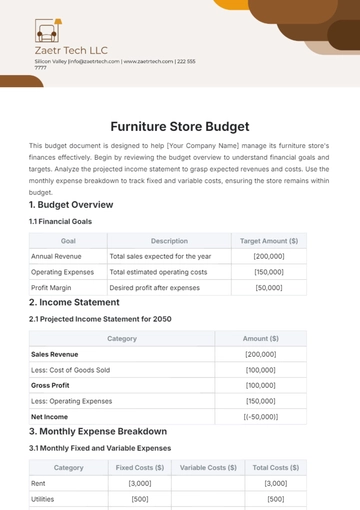Free Household Grocery Budget

Prepared by: [YOUR NAME]
Introduction
Creating a comprehensive household grocery budget is essential for effective financial management. This budget helps in tracking expenses, optimizing spending, and ensuring that nutritional needs are met without overspending. The following guide provides a detailed breakdown of the household grocery budget.
Monthly Grocery Budget Allocation
Overview of Monthly Budget
The monthly grocery budget is typically divided into various categories to ensure a balanced diet and to cater to different household needs. Below is a detailed allocation:
Category | Percentage of Total Budget | Estimated Amount (USD) |
|---|---|---|
Fruits and Vegetables | 30% | $300 |
Protein (Meat, Fish, Eggs) | 25% | $250 |
Dairy Products | 15% | $150 |
Grains and Cereals | 10% | $100 |
Snacks and Beverages | 10% | $100 |
Miscellaneous | 10% | $100 |
Weekly Grocery Shopping Plan
To maintain consistency and to avoid last-minute expenses, a weekly shopping plan is essential. Here is a suggested plan:
Week 1: Focus on buying fresh fruits and vegetables.
Week 2: Stock up on grains, cereals, and other non-perishables.
Week 3: Purchase protein products like meat, fish, and eggs.
Week 4: Buy dairy products such as milk, cheese, and yogurt.
Cost-Saving Tips
Smart Shopping Strategies
Implementing smart shopping strategies can significantly reduce grocery expenses. Consider the following tips:
Create a comprehensive shopping list to avoid impulse purchases.
Take advantage of discounts, coupons, and loyalty programs.
Buy in bulk for non-perishable items to save money in the long run.
Opt for seasonal fruits and vegetables as they are cheaper and fresher.
Avoid branded products; store brands are often just as good and cheaper.
Meal Planning
Meal planning not only saves money but also ensures that you stick to your nutritional goals. Follow these steps for effective meal planning:
Plan meals for the entire week and prepare a shopping list accordingly.
Incorporate leftovers into meals to minimize waste.
Prepare freezer-friendly meals in larger quantities to use later.
Balance meals with a variety of food groups to maintain a healthy diet.
Tracking and Adjusting the Budget
Monitoring Expenses
To ensure that the grocery budget is adhered to, it is crucial to track all expenses. Use a budgeting app or a simple spreadsheet to record all purchases:
Keep receipts and log weekly expenses in the budget tracker.
Compare the actual spend with the budgeted amounts regularly.
Identify any areas where overspending occurs and adjust accordingly.
Review the budget monthly to make necessary adjustments.
Adjusting the Budget
Based on the tracking and analysis of expenses, adjustments to the budget may be necessary. Follow these guidelines:
If certain categories are consistently overspent, reallocate funds from categories with surplus.
Ensure any changes still align with nutritional needs and priorities.
Seasonal changes might require budget adjustments; plan accordingly.
Regularly review long-term financial goals and ensure the grocery budget supports them.
- 100% Customizable, free editor
- Access 1 Million+ Templates, photo’s & graphics
- Download or share as a template
- Click and replace photos, graphics, text, backgrounds
- Resize, crop, AI write & more
- Access advanced editor
This practical Household Grocery Budget Template, exclusively offered by Template.net, customizable and editable in our AI Editor Tool, is perfect for tracking grocery spending, categorizing household needs, and planning meals while staying within your budget. This template ensures that you manage your household’s food costs effectively and avoid unnecessary overspending.
You may also like
- Budget Sheet
- Personal Budget
- Non Profit Budget
- Monthly Budget
- Project Budget
- HR Budget
- Company Budget
- Home Budget
- Weekly Budget
- College Budget
- Business Budget
- Construction Budget
- Small Business Budget
- Hotel Budget
- Annual Budget
- Home Renovation Budget
- Household Budget
- Student Budget
- Grocery Budget
- Marketing Budget
- Corporate Budget
- Startup Budget
- Manufacturing Budget
- Church Budget
- University Budget
- Annual Budget Plan
- Event Budget
- Operating Budget
- Travel Budget
- Food Budget
- IT and Software Budget
- School Budget
- Real Estate Budget
- Sales Budget
- Conference Budget
- Budget Finance
- Freelancer Budget
- Budget Advertising










